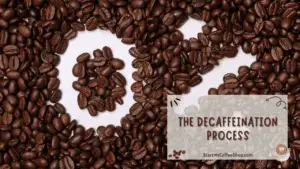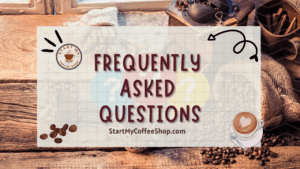Coffee has been revered for centuries as a beverage of choice all across the world due to the energetic and flavorful qualities that it imparts. Having said that, not everyone can or even wants to consume coffee. Decaffeinated coffee is an excellent choice for those individuals.
To create decaf coffee, you should start with decaffeinated coffee grounds or beans. Follow the same brewing process as you would for regular coffee, except for removing the caffeine. Delight in the rich flavors of a delicious cup of decaf while avoiding the energizing properties.
In this article, we will look at the process of making decaf coffee, several techniques of decaffeination, and advice for getting the finest decaf experience.
The Decaffeination Process

The intriguing process of decaffeination makes it possible for coffee aficionados to savor the flavors and smells of their favorite beverage without experiencing the stimulating effects that caffeine has on the body. The process of decaffeination utilizes some different methods, all of which share the common goal of removing caffeine from coffee while retaining the flavor chemicals that are responsible for the beverage’s signature flavor.
The Swiss Water Process is a well-known and widely used method of decaffeination. Because it does not entail the utilization of any chemicals, this technique is not only efficient but also kind to the surrounding ecosystem. The procedure starts with green coffee beans, which are then soaked in hot water to begin the roasting process. Caffeine and taste components are extracted from the beans by the water, resulting in a solution that has the ideal coffee flavors. Caffeine is also extracted. After that, this solution is filtered using activated charcoal, which selectively removes the caffeine while maintaining the integrity of the taste components. After being decaffeinated and thoroughly dried, the beans are now prepared to go through the roasting process.
Another typical method for decaffeination is to use techniques that include the use of solvents. When it comes to extracting caffeine from coffee beans, these techniques call for the use of either methylene chloride or ethyl acetate as the solvent. In the procedure known as direct solvent extraction, the beans are first steamed to open the pores in their skin, and then they are washed in the solvent. Caffeine molecules are efficiently extracted from the beans when a certain solvent binds to them and then removes them. After that, the solvent is evaporated, and what’s left are beans that have had their caffeine removed.
When using an indirect solvent technique, the beans start by being soaked in water. After this step, the water and the solvent are combined, and the process of extracting the caffeine can begin. In a process that is analogous to the direct solvent approach, the solvent is eventually extracted, leaving behind decaffeinated coffee beans that have retained the flavor ingredients that were sought.
Another popular method for decaffeinating coffee is the carbon dioxide (CO2) process. To remove caffeine from coffee beans in a more targeted manner, this technique makes use of liquid carbon dioxide as the extracting solvent. The procedure starts with the coffee beans being submerged in water, which allows them to swell and become more pliable. After that, the beans and the liquid carbon dioxide are placed inside a chamber that has a high level of pressure. The carbon dioxide performs the role of a solvent, and its interaction with the caffeine molecules results in a bonding effect.
The chamber is pressured, which enables the carbon dioxide to extract the caffeine while preserving the taste molecules. However, the flavor compounds are left behind. After that, the carbon dioxide and the caffeine are separated, and the caffeine is filtered out so that it can be used at a later time. This process is considered to be environmentally benign because the carbon dioxide is recycled and used again. After going through a meticulous drying process, the decaffeinated coffee beans are now prepared to go through the roasting procedure.
It is essential to keep in mind that even while these techniques for decaffeinating coffee seek to eliminate the vast majority of the caffeine, there may still be a trace amount of caffeine present in decaf coffee. The precise amount of caffeine can differ based on several factors, including the technique of decaffeination that was employed and the type of coffee beans that were used. However, as compared to regular coffee, decaf coffee contains a fraction of the amount of caffeine found in regular coffee; as a result, it is an excellent option for individuals who are caffeine-sensitive or who would simply like to reduce their consumption.
Read more about: What is the Start-up Cost for a Coffee Shop: A Penny for Your Brew
Brewing Decaf Coffee: The Same Process, Exceptional Flavor
The procedure for making decaffeinated coffee is the same as for making ordinary coffee once you have gotten decaffeinated coffee grounds or beans. Here are the steps to making a flavorful decaf cup:
- Grind the beans: For your decaf coffee to taste its freshest, grinding the beans right before brewing is crucial. Invest in a burr grinder if you drink whole-bean decaf coffee for a uniform grind size. Your preferred brewing technique will determine the grind size; for French press, medium for pour-over, and finer for espresso. Try out various grind sizes to determine which produces the finest flavor for your palate.
- Measure the coffee: A balanced and tasty cup of decaf coffee depends on the proper coffee-to-water ratio. Use the ratio suggested for the brewing technique you’ve chosen. 1 gram of coffee to 16 grams of water is a reasonable starting point for a general rule of thumb. Depending on your unique taste preferences, change the ratio to make it stronger or milder as required.
- Warm the water: The decaf coffee’s ability to extract flavors is greatly influenced by the water’s temperature. Fresh, filtered water should be heated to the proper temperature for your brewing technique. To guarantee the best extraction, the ideal water temperature is between 195°F and 205°F (90°C and 96°C). Using boiling water should be avoided since it can burn the coffee grounds and produce a bitter flavor.
- Pre-heat the equipment: Pre-heating your brewing apparatus is a straightforward but crucial step in ensuring that the ideal temperature is maintained throughout the brewing procedure. Use hot water to rinse your coffee maker, French press, or pour-over dripper to preheat it. By doing this, you can make sure that the water’s temperature stays stable and doesn’t decrease much when it comes into touch with the brewing vessel.
- Add water and coffee: After your equipment has heated up, add the right quantity of decaf coffee grounds to the brewing apparatus. To make sure the grounds are well covered, pour the boiling water over them. Gently swirl the mixture for extraction techniques like the pour-over or French press.
- Brew time: Depending on the method used, the time needed to complete the brewing process varies. Pay close attention to the suggested brew time for your particular brewing apparatus. While pour-over or French press may need a few minutes of extraction time, espresso-only needs a few seconds. To achieve the strength and taste profile you like, experiment with various brew times.
- Press or filter: After the coffee has finished brewing, remove the grounds from the coffee. To separate the liquid from the particulates, use a paper or metal filter or depress the plunger in a French press, depending on your method of choice. This process guarantees a decaf coffee cup that is free of impurities and is smooth and clean.
- Serve and enjoy: Lastly, make some decaf coffee and pour it into your preferred cup or mug. Before savoring the complex flavors, pause to enjoy the alluring scent. Knowing that you’re enjoying a lovely cup of decaf coffee without the energizing effects of caffeine will make the experience even more enjoyable.
Tips for the Best Decaf Experience
Consider the following suggestions to make the most of your experience with decaffeinated coffee:
- Quality decaffeinated coffee: Begin your decaf coffee journey with beans or grounds from reliable companies that place a premium on flavor retention during the decaffeination process. Look for accreditations or details about their dedication to excellence.
- Freshness matters: Just like with normal coffee, the flavor can be significantly affected by how recently the decaf beans or grounds were ground. For the greatest flavor, buy decaf coffee in tiny quantities or think about purchasing it from nearby roasters who can offer freshly roasted decaf coffee.
- Experiment with brewing methods: Don’t stick to just one way while making decaf coffee. Investigate how various methods, such as pour-over, French press, espresso maker, or AeroPress, impact the flavors and properties of your decaf brew.
- Adjust grind size: The grind size of your decaf coffee should be modified by the brewing technique you have selected. While coarser grinds are better suited for techniques like the French press or pour-over, finer grinds are better for espresso. To get the finest flavors and extraction from your decaf coffee, experiment with various grind sizes.
- Store properly: To keep your decaf coffee fresh and full of flavor, put it in an airtight container in a cold, dark location. It shouldn’t be kept in the refrigerator because moisture can alter the flavor. Consider the material of the container to avoid any odor transfer that can harm the flavor of your decaf coffee.
- Explore flavor profiles: Just like normal coffee, decaf coffee has a variety of flavor characteristics. Try decaf coffees from various areas or blends to determine which flavors suit your palate. To help you with your research, look for any descriptions or taste comments offered by coffee roasters.
- Enjoy with food: When drinking decaf coffee, eat items that go well with it. The flavors of decaf coffee can be complemented by pastries, dark chocolate, almonds, or even cheese to create a lovely sensory experience. Discover your favorite food pairings by experimenting with various combinations.
- Consider specialty decaf options: Specialty decaf coffee has a lot to offer. Decaffeinated versions of their premium single-origin or specialty blends are frequently offered by specialty coffee shops and roasters. These solutions give consumers the chance to taste decaf coffee with excellent flavor complexity and subtleties, eliminating any myths about its lack of character and depth. To genuinely improve your experience with decaf coffee, investigate these premium selections.
Frequently Asked Questions

Does decaf coffee contain no caffeine at all?
No, decaf coffee still contains some caffeine. A minor quantity of caffeine is often left behind after the decaffeination process to eliminate the majority of the stimulant from the coffee beans. The precise amount of caffeine may vary based on the brand and decaffeination process, although it is considerably less than ordinary coffee.
Is the flavor of decaf coffee distinct from regular coffee?
Although the difference may be minimal, decaf coffee might taste slightly different than regular coffee. The entire flavor profile can change when caffeine is removed, and some people may find that decaf coffee has a smoother or softer flavor. High-quality decaf coffee should, however, nevertheless have the distinctive tastes and nuances connected to various coffee origins.
Can I make espresso with decaf coffee beans?
Yes, Espresso can be made using decaf coffee beans. You may crush decaf coffee beans to the proper consistency and extract the flavors through the espresso brewing process whether you’re using a conventional espresso machine or an espresso-compatible coffee maker. To obtain the best possible extraction and flavor balance, it’s crucial to modify the brewing parameters and grind size.
To learn more on how to start your own coffee shop, check out my startup documents here.
Disclaimer: The information provided by StartMyCoffeeShop.com (“The Site”) is for general informational purposes only. All information on the Site is provided in good faith. However, we make no representation or warranty of any kind, express or implied, regarding the accuracy, adequacy, validity, reliability, availability, or completeness of any information on the Site. Under no circumstance shall we have any liability to you for any loss or damage of any kind incurred as a result of the use of the Site or Reliance on any information provided on the Site. Your use of the Site and reliance on any information on the Site is solely at your own risk. This blog post is for educational purposes only and does not constitute legal advice. Please consult a legal expert to address your specific needs. Terms and Conditions. (https://startmycoffeeshop.com/terms-and-conditions/)

Hi! I’m Shawn Chun
My adventure in coffee began when I first launched my first coffee shop back in the early 2000s. I had to figure out so many things on my own and to make it worse within 2 years of opening two large corporate coffee chains moved in just blocks away from me!
As I saw smaller and even some larger coffee shops in the neighborhood slowly lose customers to these giant coffee chains and slowly close up shop, I knew that I had to start getting creative…or go out of business.
I (like you may be) knew the coffee industry well. I could make the best latte art around and the foam on my caps was the fluffiest you have ever seen. I even had the best state-of-the-art 2 group digital Nuova Simonelli machine money could buy. But I knew that these things alone would not be enough to lure customers away from the name brand established coffee shops.
Eventually, through lots of trial and error as well as perseverance and creativity I did find a way to not only survive but also thrive in the coffee/espresso industry even while those corporate coffee chains stayed put. During those years I learned to adapt and always faced new challenges. It was not always easy, however, in the end, I was the sole survivor independent coffee shop within a 10-mile radius of my location. Just two corporate coffee chains and I were left after that year. All told the corporate coffee chains took down over 15 small independent coffee shops and kiosks and I was the last one standing and thriving.
Along the years I meet others with the same passion for coffee and I quickly learned that it is not only “how good a barista is” that makes a coffee shop successful, but the business side of coffee as well.
Hence why I started this website you are on now. To provide the tools and resources for up and coming coffee shop owners to gain that vital insight and knowledge on how to start a coffee shop successfully.
Stick around, browse through my helpful blog and resources and enjoy your stay! With lots of LATTE LOVE!
Shawn







